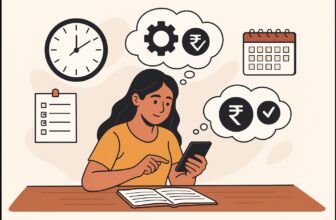It starts small, just five minutes on Instagram, one news alert, a quick scroll through WhatsApp. Before you know it, you’ve lost two hours, your neck hurts, and your mind feels foggy. This is the new normal for millions across India.
Whether you’re a student juggling classes and reels, a parent lost in OTT marathons, or a professional stuck in back-to-back Zoom calls, screens are quietly consuming your energy. The result? Eye strain, poor sleep, anxiety, and a growing disconnection from the real world around you.
A digital detox is your way out, without quitting technology altogether. It’s about regaining control, slowing down, and making space for things that truly matter: clear thinking, restful evenings, time with loved ones, and even boredom, the good kind.
This listicle walks you through 11 practical and realistic detox methods, especially suited to how we live in India, across small apartments, busy homes, and digital workspaces. No judgment, no extreme challenges. Just simple shifts you can try, one habit at a time.
1. Set Specific Digital-Free Hours
Create screen-free slots in your daily routine.
Example: No devices after 9 PM. Use a bedside alarm instead of checking your phone first thing in the morning.
2. Try Detox Apps to Transition Gradually
If quitting suddenly is hard, use your phone to limit itself.
Example: Apps like Digital Wellbeing (Android) or YourHour allow you to block or limit time on apps like Instagram or YouTube.
3. Make Certain Zones Device-Free
Designate “no-phone” spaces in your home.
Example: Keep the dining area, temple corner, or bedroom free from digital interference to encourage real conversations or mindful habits.
4. Start with a One-Day Detox Challenge
Choose a Sunday or public holiday to stay offline and experience a full day without digital noise.
Example: Visit Lodhi Garden in Delhi or take a walk by the beach in Chennai without your phone.
5. Replace Scrolling with Offline Hobbies
Discover things you enjoy without screens.
Example: Try sketching rangoli, indoor gardening, or taking tabla or cooking classes at a local community center.
6. Switch to Print and Paper
Use physical alternatives to digital tools where possible.
Example: Use a paper diary or planner instead of Google Calendar, and pick up a real book instead of eBooks.
7. Silence Notifications and Set App Timers
Control your digital interruptions rather than letting them control you.
Example: Mute non-essential WhatsApp groups and use app timers to cut Instagram or YouTube usage to 30 minutes a day.
8. Try a Basic Phone on Detox Days
Use a feature phone for essential calls during your detox period.
Example: Switch to a Nokia 105 for the weekend while your smartphone stays in a drawer.
9. Spend Time Outdoors Without Screens
Reconnect with nature and give your eyes a rest from screens.
Example: Morning walks in Cubbon Park (Bangalore) or evening strolls in your neighborhood park, leaving your phone at home.
10. Inform Family and Work Contacts About Your Detox
Set clear expectations with those who may message or call you frequently.
Example: Update your WhatsApp status with: “On a short digital detox. Will check messages after 7 PM.”
11. Join Community Events or Volunteer Offline
Real-life connections replace screen time better than solitude.
Example: Participate in a temple cleaning drive, teach at an NGO, or volunteer at local food distribution camps.
Why Digital Detox Is Becoming Critical in India
India’s digital landscape has exploded over the past decade. With more than 1.2 billion mobile connections and some of the highest daily screen times in the world, Indians are living increasingly digital lives.
- Online classes, remote work, UPI payments, OTT bingeing, and endless WhatsApp groups blur the line between personal and screen time.
- Young users in metros like Delhi and Mumbai average 7+ hours of screen time daily, often at the cost of sleep, posture, and real-life socializing.
- Even tier-2 and rural areas now face overuse of short-form video apps and gaming platforms.
Why It’s Harder to Break Free
A few things make digital detox tougher for Indians:
- Work expectations in IT, BPO, and remote roles often demand round-the-clock availability.
- Family pressures to instantly respond on WhatsApp groups or share updates on birthdays and festivals.
- Students are glued to Reels, Shorts, and games like BGMI or Free Fire, often under the excuse of “relaxing.”
In India, a detox is not just a lifestyle change it often feels like going against social expectations.
What It’s Doing to Your Health
- Eye strain and rising myopia in kids and teens due to prolonged exposure to screens.
- Chronic neck and back pain caused by poor posture while using mobile phones or laptops.
- Blue light exposure at night disturbs natural sleep cycles, leading to poor rest and fatigue.
- Mental fatigue, loss of concentration, and digital anxiety from constant multitasking.
Detoxing by Life Stage: Tailoring Your Approach
- Students: Combine detox with focused exam prep use paper notes and reduce distractions.
- Young professionals: Try weekend detoxes and block work mail outside hours.
- Homemakers and retirees: Reduce OTT usage, unsubscribe from unwanted WhatsApp groups, and try community meetups.
Reconnect with Life, Not Just Wi-Fi
Digital detox isn’t about rejecting technology, it’s about reclaiming balance in a screen-saturated life. In India, where smartphones and online platforms dominate education, work, and leisure, taking intentional breaks from screens is essential for your mental clarity, sleep, posture, and real-world connections.
By easing back into offline habits, you’ll find more time, less stress, and a stronger connection to the people and world around you.





